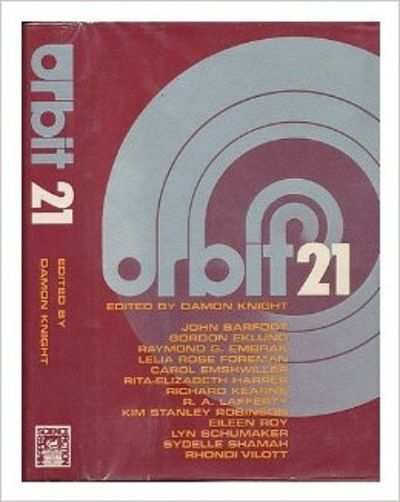This Is The End
Orbit 21 (Orbit, volume 21)
Edited by Damon Knight

22 Mar, 2022
Orbit 21 (1980) is the 21st and final volume in Damon Knight’s Orbit original-SF anthology series.
Orbit 21 contains thirteen stories, seven by seven women and six by six men.
While not as good as Orbits 6 or 7, Orbit 21 is not an excessively bad final installment. Some stories were quite diverting. Alas, if ISFDB can be trusted, not only were none of the stories nominated for major awards, but the vast majority of the stories (nine out of thirteen) were never reprinted1: voters and anthologists seem to have been equally unenthused by this collection.
I also note that many of the authors in this volume did not go on to enjoy long careers in the field. The authors who did keep publishing tended to have already had established their careers before appearing in Orbit. There are two notable exceptions:
“Persephone” seems to have been Rhondi A. Vilott Salsitz’s debut (she has been prolific, under numerous pen names).
Kim Stanley Robinson, who I believe debuted in Orbit 18, has enjoyed a certain level of on-going success in the field.
On the minus side is Gordon Eklund, who was fairly prolific in the 1970s but whose output dropped precipitously after 1980.
Knight, the editor, is very up front about why the series ended: declining sales. This was an issue that began with Orbit 6, and when belatedly noticed, drove a move to a new publisher after Orbit 13.
None of the stories in this volume are all that bad, although there are some that are unmemorable. For the most part, Orbit 21 is a collection of competent but not outstanding stories that riff on themes dear to Knight.
The entries that stood out for me: Knight’s introduction, and as much as I hate to admit this in print, Kim Stanley Robinson’s Icehenge story.
Orbit 21 is out of print.
Introduction: About Fifteen Years of Orbit • (1980) • essay by Damon Knight
An interesting retrospective take on the series, which (he says) was designed to show that:
science fiction is a field of literature worth taking seriously, and that ordinary critical standards can be meaningfully applied lo it: e.g., originality, sincerity, style, construction, logic, coherence, sanity, garden-variety grammar.
Knight muses not just on what he sought out, but on material he declined, some of which went on to win awards.
“Love, Death, Time, and Katie” • (1980) • short story by Richard Kearns
A romantic struggles to protect his loved one from death; that proves a misguided effort.
“The Greening” • (1980) • short story by Eileen Roy
A human woman visits aliens in the hope of learning a secret she can use to reverse humanity’s terrible mistakes. Alas, there are no do-overs.
“Abominable” • (1980) • short story by Carol Emshwiller
Manly men celebrate the manly world made possible by comprehensive gendercide.
This could very easily be a sequel to Tiptree’s “The Screwfly Solution.”
“Underwood and the Slaughterhouse” • (1980) • short story by Raymond G. Embrak
A world in which conformity is a bulwark against pandemic demands sacrifice.
Well, this aged interestingly.
Terrible worlds where people believe they must do terrible things is something of a running theme in this volume.
“Hope” • (1980) • short story by Lelia Rose Foreman
Castaways on an inhospitable planet live in hope of rescue, a hope that is cruelly answered.
The planet is only very slightly inhospitable — a small excess of deadly life, a minor shortage of vital elements — but it’s sufficiently hostile that this accidental colony is certainly doomed.
“The Mother of the Beast” • short story by Gordon Eklund
A mother tends to her monstrous children; diligence is rewarded with tragedy.
Yes, very different from the previous story while sharing some themes. Knight knew what he liked.
Robert Fraser: The Xenologist as Hero • (1980) • short story by Sydelle Shamah
A woman with peculiar needs forms a destructive but productive partnership with a terminally ill researcher whose needs match with hers.
“Persephone” • (1980) • short story by Rhondi Vilott
Drawn into war, a woman soldier assesses her life and finds it sorely wanting. Her husband, who profits from her service, is unsupportive.
The Smell of the Noose, The Roar of the Blood • (1980) • novelette by John Barfoot
Society, bored by simulation, turns to real violence and death for entertainment.
How many of these stories were there? And wasn’t 1973’s “Roller Ball Murder” the peak example?
“And the TV Changed Colors When She Spoke” • (1980) • short story by Lyn Schumaker
A woman is subjected to lengthy abuse, for which a misogynist world offers no recourse.
“The Only Tune That He Could Play” • (1980) • short story by R. A. Lafferty
Sometimes the only reward for outstanding performance is a lance through the chest.
“Survivors” • (1980) • short story by Rita-Elizabeth Harper
In the brutal world of tomorrow, survival demands determination and sacrifice, particularly from women.
On the North Pole of Pluto • (1980) • novella by Kim Stanley Robinson
The discovery of a henge on Pluto provokes heated debate over its origins.
I was reminded of the “L’Anse aux Meadows is a modern fake!” controversy. But perhaps something else entirely inspired this story. It’s not as there were any shortage of archaeological fakes KSR could have had in mind when he wrote this tale of battling hypotheses and dueling evidence.
1: Robinson’s piece was reworked and incorporated in Icehenge. I count that as a reprint.
